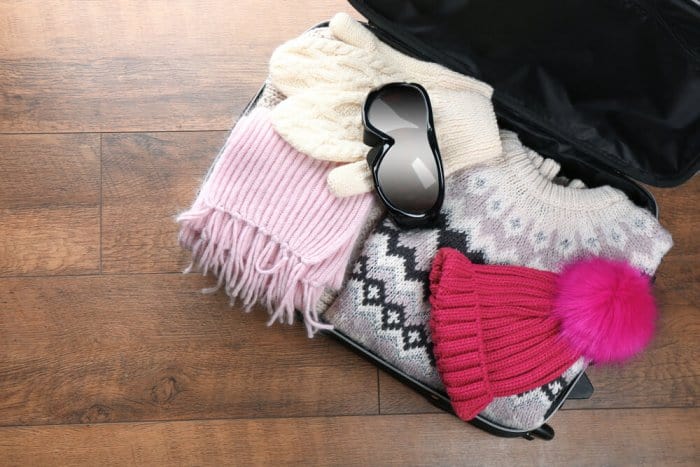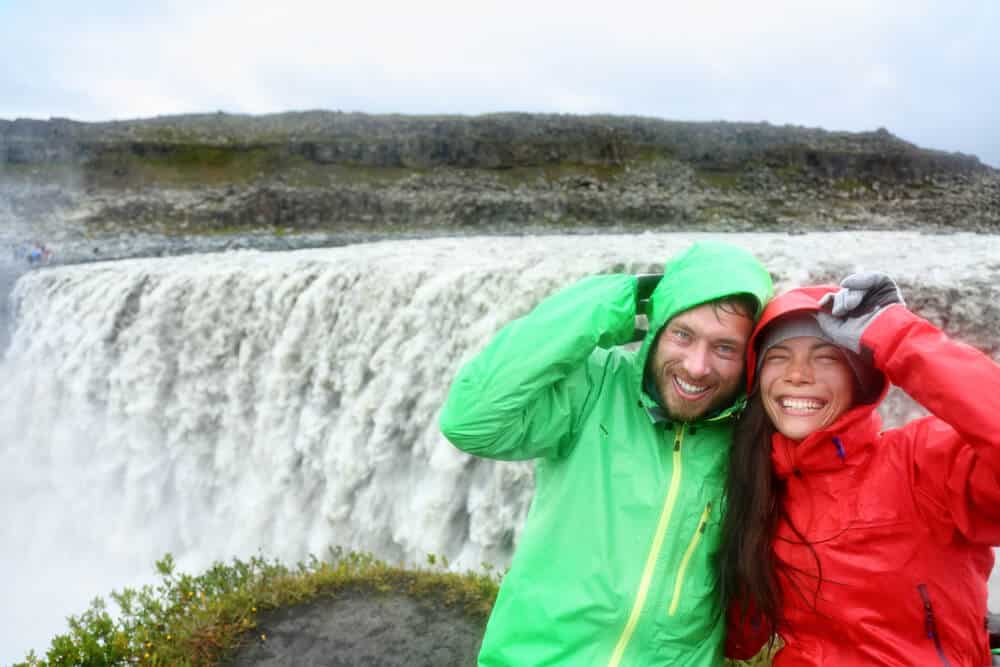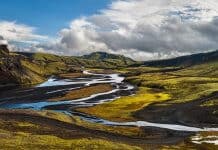When planning a trip to Iceland, one of the first big questions you’ll have to answer is when is the best month to visit. October is considered a good time to go for multiple reasons. The days are relatively long, and the country’s spectacularly sparkling emerald Northern Lights are on full display. The burnt oranges and crisp yellows of fall foliage have arrived. That being said, October is also one of the wettest months in Iceland, and it rains most days. That doesn’t mean you should stay away. Iceland’s weather in October can be rainy with lots of drizzle, yes. But as long as you prepare with the right clothing, you’ll be ready to face the elements and stay warm, toasty, and dry, regardless of the season.

How Cold is it in Iceland in October?
I’m not going to lie. The reading on the thermometer in Iceland in October is probably lower than what you are used to. While it’s not unbearably freezing, it does mimic winter temperatures in many parts of the world. The average high in October in Reykjavik is around 45 °F (7 ºC). The lows dip down to about 36 ºF (2 ºC).
- Average October High: 45 °F (7 °C)
- Average October Low: 36 °F (2 °C)
In addition to being cold, it’s also extremely wet in Iceland in October. What part of the country you visit also determines how much precipitation you will encounter. The south coast of the country (think Vik and Vatnajökull National Park) gets around four times as much rain as the North (Akureyri for example). Average monthly rainfall in October is up to 5 inches (nearly 13 centimeters). It’s essential to pack the right clothing in your suitcase for your trip. This will take you quite far in making your time in Iceland as enjoyable as possible.
What Should I Pack for Iceland in October?
We’ve already established that it’s going to be cold and wet. This means you will need a mixture of both warm, thermal pieces and waterproof clothing, footwear, and outerwear. Layering is key. If you follow the guidelines of the three layer rule, you’ll have a much better time in Iceland than if you just piled on a bunch of sweaters, put on two or three pairs of socks, and hoped for the best. That’s a total rookie move and you’re no novice! You’re an Iceland packing expert! Or at least you will be after reading this section. We’ll cover advice on how to dress for cold weather and keep out the chill, wind, and rain.
There’s a famous saying in places like Vancouver, London, and Reykjavik (all known for their overcast, grey skies and misty, rainy weather). There’s no such thing as bad weather, only bad clothing. So let’s find out the right items to pack for your trip.

The Three Layer Rule
You need to start with a base layer of thermal underwear. The perfect fabrics will not only be breathable but trap body heat as well. Wool and silk are great for these. Merino wool is especially popular among those who spent a lot of time outdoors in cold weather or freezing climates. One of the amazing qualities of this material is the ability to absorb large amounts of moisture without getting wet. Your thermal underwear set should include at minimum a top, pants, and wool socks.
Your middle layer needs to be one for insulation. A fuzzy, fluffy fleece jumper is the perfect choice. This miracle material is soft and breathable and will have you feeling warm and cozy. It makes for the perfect in-between, buffer layer to rest between your thermal base layer and your waterproof, wind-blocking outer layer. Fleece is also water resistant and lightweight, so it’s the perfect versatile fabric and fundamental to proper layering.
Your outermost shell layer is designed to protect you from the elements. One of the best pieces of advice I can give to anyone traveling in Iceland is to invest in a good rain jacket. It’s not enough to be water-resistant, however. Make sure that you buy outerwear that actually says that it is waterproof. In addition to downpours that come out of nowhere, it’s also likely that you’re going to participate in an activity where you might get lightly sprayed or misted with water. I’m thinking of things like whale watching excursions or hiking close to one of the country’s numerous waterfalls. The last thing you want is to have moisture creeping in, chilling you to the bone, and ruining all of your layering hard work.

Other Items to Pack for Iceland
A windbreaker will go a long way in keeping you comfortable as well. Iceland is a windy place and that chilling wind can cut through your layers if you are not properly dressed with the right items. It also goes without saying that you want to pick up a nice sturdy pair of waterproof hiking boots to complete your collection of items for staying warm and dry in Iceland.
Length of Days in October
Iceland gets a fair amount of daylight hours during the month of October. As with many countries in northern latitudes, the small Nordic island loses several minutes per day of sunlight as we approach the winter equinox. The beginning of the month sees over 11 hours of sunshine with the sun rising shortly after 7:30 a.m. and setting around 7 p.m. By the end of the month, that number is reduced to around 8 hours with the sun rising around 9 a.m. and setting between 5 and 5:30 p.m.
- Sunrise 7:36 a.m. – Sunset 6:56 p.m. (October 1st)
- Sunrise 8:17 a.m. – Sunset 6:08 p.m. (October 15th)
- Sunrise 9:07 a.m. – Sunset 5:14 p.m. (October 31st)
October Weather in Iceland: Rain Rain Go Away!
So as we’ve seen, October is a great month to visit Iceland. As long as you’re prepared with the right clothing and know what to expect with the weather, you will be happy you came. The crowds of summer have left, prices for everything are lower, and you are able to do many things you could not do during the warmer months. Bundle up, bring a rain jacket and waterproof boots, and get ready for your adventure in Iceland.

































